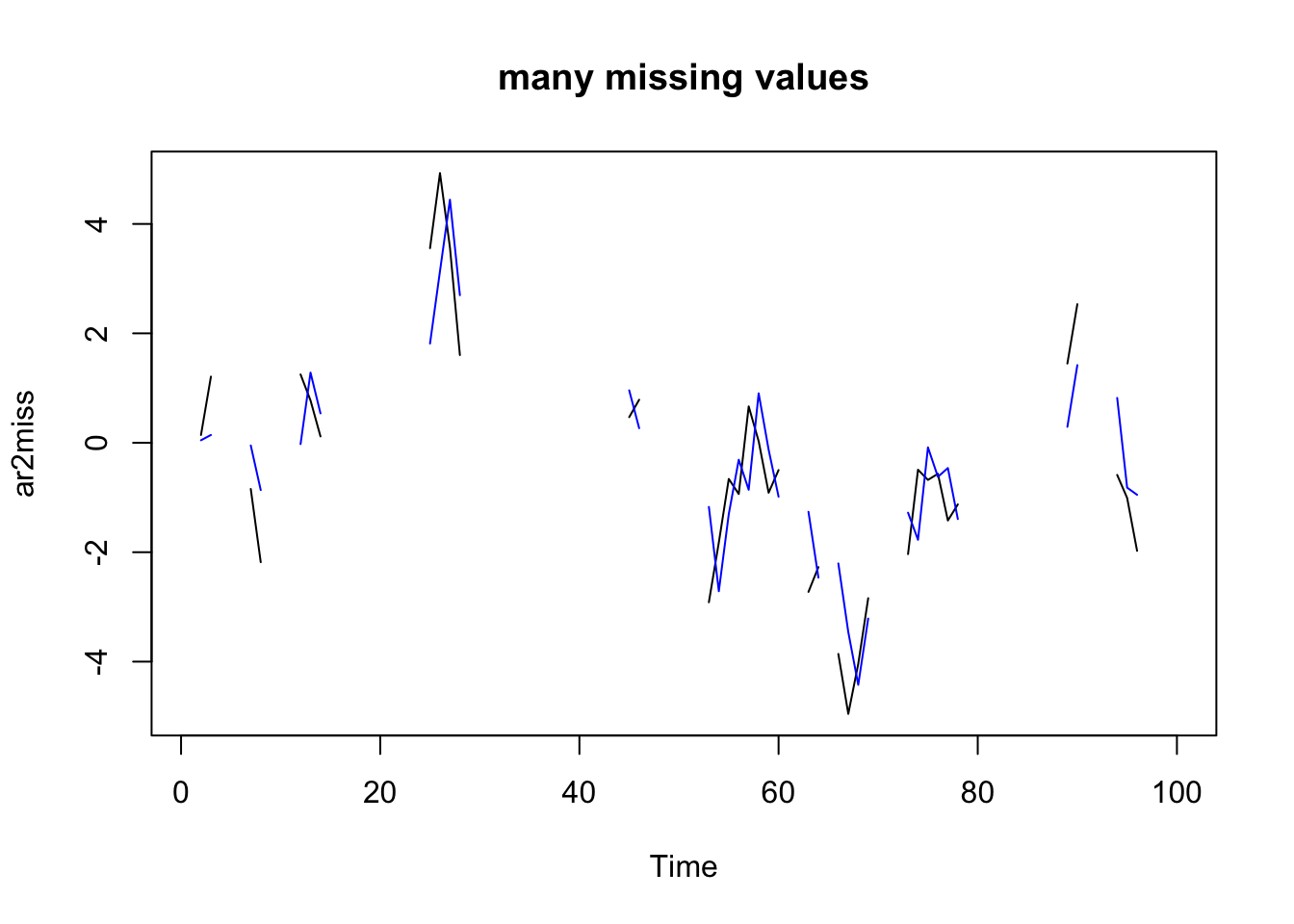5.7 Estimating ARMA parameters
Let’s start with fitting to simulated data.
5.7.1 AR(2) data
Simulate AR(2) data and add a mean level so that the data are not mean 0.
\[\begin{equation} \begin{gathered} x_t = 0.8 x_{t-1} + 0.1 x_{t-2} + e_t\\ y_t = x_t + m \end{gathered} \end{equation}\]
m <- 1
ar2 <- arima.sim(n = 1000, model = list(ar = c(0.8, 0.1))) +
mTo see info on arima.sim(), type ?arima.sim.
5.7.2 Fit with Arima()
Fit an ARMA(2) with level to the data.
forecast::Arima(ar2, order = c(2, 0, 0), include.constant = TRUE)Series: ar2
ARIMA(2,0,0) with non-zero mean
Coefficients:
ar1 ar2 mean
0.7684 0.1387 0.9561
s.e. 0.0314 0.0314 0.3332
sigma^2 estimated as 0.9832: log likelihood=-1409.77
AIC=2827.54 AICc=2827.58 BIC=2847.17Note, the model being fit by Arima() is not this model
\[\begin{equation} y_t = m + 0.8 y_{t-1} + 0.1 y_{t-2} + e_t \end{equation}\]
It is this model:
\[\begin{equation} (y_t - m) = 0.8 (y_{t-1}-m) + 0.1 (y_{t-2}-m)+ e_t \end{equation}\]
or as written above: \[\begin{equation} \begin{gathered} x_t = 0.8 x_{t-1} + 0.1 x_{t-2} + e_t\\ y_t = x_t + m \end{gathered} \end{equation}\]
We could also use arima() to fit to the data.
arima(ar2, order = c(2, 0, 0), include.mean = TRUE)Warning in arima(ar2, order = c(2, 0, 0), include.mean = TRUE): possible
convergence problem: optim gave code = 1
Call:
arima(x = ar2, order = c(2, 0, 0), include.mean = TRUE)
Coefficients:
ar1 ar2 intercept
0.7684 0.1387 0.9561
s.e. 0.0314 0.0314 0.3332
sigma^2 estimated as 0.9802: log likelihood = -1409.77, aic = 2827.54However we will not be using arima() directly because for if we have differenced data, it will not allow us to include and estimated mean level. Unless we have transformed our differenced data in a way that ensures it is mean zero, then we want to include a mean.
Try increasing the length of the simulated data (from 100 to 1000 say) and see how that affects your parameter estimates. Run the simulation a few times.
5.7.3 AR(1) simulated data
ar1 <- arima.sim(n = 100, model = list(ar = c(0.8))) + m
forecast::Arima(ar1, order = c(1, 0, 0), include.constant = TRUE)Series: ar1
ARIMA(1,0,0) with non-zero mean
Coefficients:
ar1 mean
0.7091 0.4827
s.e. 0.0705 0.3847
sigma^2 estimated as 1.34: log likelihood=-155.85
AIC=317.7 AICc=317.95 BIC=325.515.7.4 ARMA(1,2) simulated data
Simulate ARMA(1,2) \[x_t = 0.8 x_{t-1} + e_t + 0.8 e_{t-1} + 0.2 e_{t-2}\]
arma12 = arima.sim(n = 100, model = list(ar = c(0.8), ma = c(0.8,
0.2))) + m
forecast::Arima(arma12, order = c(1, 0, 2), include.constant = TRUE)Series: arma12
ARIMA(1,0,2) with non-zero mean
Coefficients:
ar1 ma1 ma2 mean
0.8138 0.8599 0.1861 0.3350
s.e. 0.0646 0.1099 0.1050 0.8145
sigma^2 estimated as 0.6264: log likelihood=-118.02
AIC=246.03 AICc=246.67 BIC=259.06We will up the number of data points to 1000 because models with a MA component take a lot of data to estimate. Models with MA(>1) are not very practical for fisheries data for that reason.
5.7.5 These functions work for data with missing values
Create some AR(2) data and then add missing values (NA).
ar2miss <- arima.sim(n = 100, model = list(ar = c(0.8, 0.1)))
ar2miss[sample(100, 50)] <- NA
plot(ar2miss, type = "l")
title("many missing values")
Fit
fit <- forecast::Arima(ar2miss, order = c(2, 0, 0))
fitSeries: ar2miss
ARIMA(2,0,0) with non-zero mean
Coefficients:
ar1 ar2 mean
1.0625 -0.2203 -0.0586
s.e. 0.1555 0.1618 0.6061
sigma^2 estimated as 0.9679: log likelihood=-79.86
AIC=167.72 AICc=168.15 BIC=178.06Note fitted() does not return the expected value at time \(t\). It is the expected value of \(y_t\) given the data up to time \(t-1\).
plot(ar2miss, type = "l")
title("many missing values")
lines(fitted(fit), col = "blue") It is easy enough to get the expected value of \(y_t\) for all the missing values but we’ll learn to do that when we learn the MARSS package and can apply the Kalman Smoother in that package.
It is easy enough to get the expected value of \(y_t\) for all the missing values but we’ll learn to do that when we learn the MARSS package and can apply the Kalman Smoother in that package.